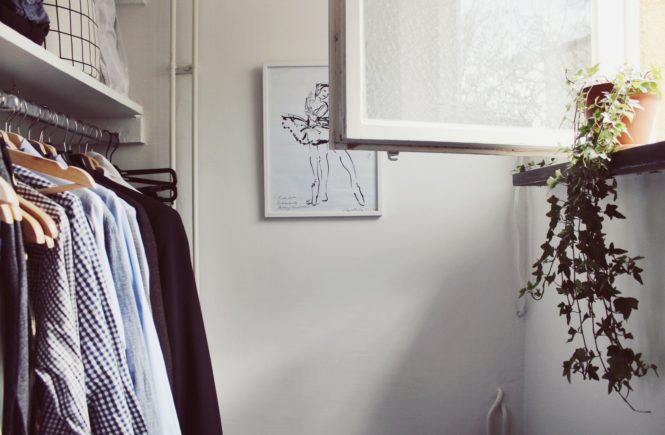Having a sustainable wardrobe means making the most of what you have – by buying long-lasting pieces, and taking care of them to ensure their long life. But for various reasons we still end up with clothes we stop wearing after a while, and often, this is due to some minor, fixable issue. Like, it needing a new button, or a fixed seam, or simply some TLC. These are most likely easy fixes but it’s still hard to get ’round to fixing them.
April’s challenge in the Slow Fashion Challenge I’m taking part in this year is therefore aimed at clothes care, and taking better care of my clothes was also one of my goals for the year.
Pick a day to do it, or make a plan to have a clothes care day each month. For the sake of the challenge, I picked a day when I worked my way through the wardrobe.
During earlier parts of the challenge, I’ve already gone through the wardrobe and done a bit of an audit, to have a clearer idea of what I own, what I regularly use, and what I don’t use very often. In the don’t-use-very-often-pile, I found various pieces of clothing that needed a bit of care before they could be seen out, so they ended up in the fixing-pile (together with some of my partner’s clothes that also needed fixing).
Hand washing delicates
I’ve had various pieces of clothing made from silk and silk-like delicate materials that have been left in the laundry basket for ages because they can’t be washed with the rest of our clothing. So task one was to hand-wash them, and I then hung them out to dry on the balcony.

Cleaning by not washing
One reason we wear out our clothes sooner than we need to is that we wash them too often, whilst also using extra energy, water, and detergent that we could also be saving. So one top tip to make your clothes last longer is to only wash them when you think you definitely need to. Spot-treat stains rather than throw the whole item in the washing machine, or hang things out to get some fresh air (this works especially well with wool clothing that cleans itself if hung out to breathe). I’m also using a clothing mist to freshen up clothes that don’t necessarily need washing but are feeling a bit not-so-clean (a lot of cleaning products use unnecessary chemicals so to be kinder to the planet, try to pick one that’s more environmentally friendly), and as I’m lucky enough to have a window in my small walk-in closet, I’ve done some airing to freshen up the whole wardrobe at once.

The wool treatment
Next up were various pieces of clothing made from wool that had started to look tired because of pilling. There are various tools for this but the eco-friendly options I’ve gone for are brushes and a sweater stone. The brush can be used to remove residue and some pilling, whilst also giving wool pieces a bit of extra shine that they may have lost. For items with a bit more pilling, the sweater stone is probably a better option as it catches the pilling better.

Sewing and mending and fixing
It’s all so easy to forget about clothes and not wear them because they’re missing a button, but actually it’s a pretty easy thing to fix. Buttons and smaller holes are fairly easy but there are of course bigger issues that may require a bit of help so might be worth asking a grandmother or a friend who knows this to help you. Or ask a professional if you’re feeling unsure.
As a teenager I used to do a lot of sewing but haven’t done any for many, many years. But with a needle and some thread I at least managed to fix some smaller holes and buttons.

Giving your clothes some proper care every now and then will definitely make them last longer, but taking the time to do it is often harder. It can be time consuming, it can be a bit tricky, and it can be boring. That’s why picking a day every month, or setting yourself a challenge is a great option – it most definitely worked for me!

